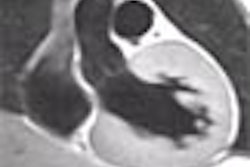BALTIMORE - The use of pelvic MRI in women who are potential candidates for uterine fibroid embolization (UFE) increases the physician’s confidence in their diagnosis and helps avoid improper treatment, according to researchers from Northwestern University Medical School in Chicago. The results were presented Sunday at the Society of Cardiovascular and Interventional Radiology (SCVIR) meeting.
The team tracked 60 women who came to Northwestern presenting with uterine fibroids. The initial treatment plan suggested by the attending physician before seeing the MRI was UFE in all but three cases. The attending physician was then shown an MR scan and was asked to reconsider the diagnosis and proposed treatment.
In 11 patients, representing 18% of subjects studied, the doctors changed their initial diagnoses. In 22% of the cases, the treatment plan was changed. In eight cases, women who would have received UFE were instead recommended for surgery. In two potential UFE patients, clinical management was deemed most appropriate, and one would-be UFE patient was referred for biopsy.
"In many cases, these women would have been treated with UFE, even though it isn’t the right thing to do," said Dr. Reed Omary, the faculty radiologist at Northwestern who led the study.
In UFE, an interventional radiologist cuts off the blood supply to the fibroid by using a noninvasive, catheter-based approach in which tiny polymers are lodged in the blood vessels around the fibroid. The lack of blood shrinks the tumor.
Traditionally, ultrasound has been used to diagnose and determine treatment for fibroids, but MRI is becoming a more and more important tool because of its diagnostic power, Omary said. "We don’t trust ultrasound anymore," because the diagnostic confidence and accuracy of MRI has been shown to exceed that of ultrasound. In many cases, Omary said the pre-MRI decisions were based on ultrasound exams, but that modality did not offer the power of MRI.
Before the MRI was obtained, the doctors’ confidence in their own diagnoses was about 76%. After the MRI, confidence shot up to 98%.
Omary recommended that the procedure be used routinely in evaluating women with the symptoms of fibroids.
Still, performing an MRI would add additional costs to the treatment of fibroids. "I would be careful," cautioned Dr. Klaus Hagspiel, a professor of radiology at the University of Virginia in Charlottesville, who chaired the session. "MRI is a very expensive procedure."
By Brian ReidAuntMinnie.com contributing writer
April 8, 2002
Related Reading
Uterine artery embolization shrinks fibroids; most patients satisfied with results, March 29, 2002
UFE gets boost from public education effort, March 6, 2002
Uterine fibroid embolization can be done without ob/gyn support, March 8, 2001
Copyright © 2002 AuntMinnie.com



.fFmgij6Hin.png?auto=compress%2Cformat&fit=crop&h=100&q=70&w=100)




.fFmgij6Hin.png?auto=compress%2Cformat&fit=crop&h=167&q=70&w=250)











